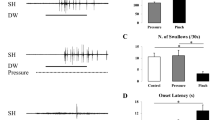Abstract
The swallowing reflex is centrally programmed by the lower brain stem, the so-called swallowing central pattern generator (CPG), and once the reflex is initiated, many muscles in the oral, pharyngeal, laryngeal, and esophageal regions are systematically activated. The mylohyoid (MH) muscle has been considered to be a “leading muscle” according to previous studies, but the functional role of the digastric (DIG) muscle in the swallowing reflex remains unclear. In the present study, therefore, the activities of single units of MH and DIG neurons were recorded extracellularly, and the functional involvement of these neurons in the swallowing reflex was investigated. The experiments were carried out on eight adult male Japanese white rabbits anesthetized with urethane. To identify DIG and MH neurons, the peripheral nerve (either DIG or MH) was stimulated to evoke action potentials of single motoneurons. Motoneurons were identified as such if they either (1) responded to antidromic nerve stimulation of DIG or MH in an all-or-none manner at threshold intensities and (2) followed stimulation frequencies of up to 0.5 kHz. As a result, all 11 MH neurons recorded were synchronously activated during the swallowing reflex, while there was no activity in any of the 7 DIG neurons recorded during the swallowing reflex. All neurons were anatomically localized ventromedially at the level of the caudal portion of the trigeminal motor nucleus, and there were no differences between the MH and DIG neuron sites. The present results strongly suggest that at least in the rabbit, DIG motoneurons are not tightly controlled by the swallowing CPG and, hence, the DIG muscle is less involved in the swallowing reflex.




Similar content being viewed by others
References
Jean A. Brain stem control of swallowing: neuronal network and cellular mechanisms. Physiol Rev. 2001;81:929–69.
Doty RW, Bosma JF. An electromyographic analysis of reflex deglutition. J Neurophysiol. 1956;19:44–60.
Thexton AJ, Crompton AW, German RZ. Electromyographic activity during the reflex pharyngeal swallow in the pig: Doty and Bosma (1956) revisited. J Appl Physiol. 2007;102:587–600.
Naganuma K, Inoue M, Yamamura K, Hanada K, Yamada Y. Tongue and jaw muscle activities during chewing and swallowing in freely behaving rabbits. Brain Res. 2001;915:185–94.
Takata H. A comparative anatomical study on suprahyoid muscles. Kyushu Dental Soc. 1989;43:899–913.
Inoue M, Nozawa-Inoue K, Donga R, Yamada Y. Convergence of selected inputs from sensory afferents to trigeminal premotor neurons with possible projections to masseter motoneurons in the rabbit. Brain Res. 2002;957:183–91.
Donga R, Lund JP, Veilleux D. An electrophysiological study of trigeminal commissural interneurons in the anaesthetized rabbit. Brain Res. 1990;515:351–4.
Landgren S, Olsson KA. Localization of evoked potentials in the digastric, masseteric, supra- and intertrigeminal subnuclei of the cat. Exp Brain Res. 1976;26:299–318.
Meessen H, Olszewski J. Cytoarchitektonischer Atlas des Rautenhirns des Kaninchens. Basel: Karger; 1949.
Weijs WA, Dantuma R. Functional anatomy of the masticatory apparatus in the rabbit. Netherlands J Zool. 1981;31:99–147.
Fukuhara T, Tsujimura T, Kajii Y, Yamamura K, Inoue M. Effects of electrical stimulation of the superior laryngeal nerve on the jaw-opening reflex. Brain Res. 2011;1391:44–53.
Sumi T. Modification of cortically evoked rhythmic jaw movements by reflex deglutition in rabbits. Jpn J Physiol. 1977;27:391–8.
Takagi M, Noda T, Yamada Y. Comparison of SLN-evoked swallows during rest and chewing in the freely behaving rabbit. Brain Res. 2002;956:74–80.
Lund JP. Mastication and its control by the brain stem. Crit Rev Oral Biol Med. 1991;2:33–64.
Nakamura Y, Katakura N. Generation of masticatory rhythm in the brainstem. Neurosci Res. 1995;23:1–19.
Yamada Y, Yamamura K, Inoue M. Coordination of cranial motoneurons during mastication. Respir Physiol Neurobiol. 2005;147:177–89.
Amarasena J, Ootaki S, Yamamura K, Yamada Y. Effect of cortical masticatory area stimulation on swallowing in anesthetized rabbits. Brain Res. 2003;965:222–38.
Meng Y, Uchida K, Sato T, Yamamura K, Yamada Y. Difference in the burst patterns of digastric and mylohyoid activities during feeding in the freely behaving rabbit. Dysphagia. 1999;14:78–84.
Konow N, Thexton A, Crompton AW, German RZ. Regional differences in length change and electromyographic heterogeneity in sternohyoid muscle during infant mammalian swallowing. J Appl Physiol. 2010;109:439–48.
Umapathi T, Venketasubramanian N, Leck KJ, Tan CB, Lee WL, Tjia H. Tongue deviation in acute ischaemic stroke: a study of supranuclear twelfth cranial nerve palsy in 300 stroke patients. Cerebrovasc Dis. 2000;10:462–5.
van Lunteren E, Dick TE. Heterogeneity within geniohyoid motor unit subpopulations in firing patterns during breathing. Respir Physiol. 2001;124:23–33.
Baisden RH, Woodruff ML, Whittington DL, Benson AE. The motor innervation of the single-bellied digastric muscle in the rabbit: a retrograde horseradish peroxidase study. Neurosci Lett. 1985;56:129–36.
German RZ, Campbell-Malone R, Crompton AW, Ding P, Holman S, Konow N, Thexton AJ. The concept of hyoid posture. Dysphagia. 2011;26(2):97–8.
Matsuda K, Uemura M, Kume M, Matsushima R, Mizuno N. Topographical representation of masticatory muscles in the motor trigeminal nucleus in the rabbit: a HRP study. Neurosci Lett. 1978;8:1–4.
Inoue M, Ariyasinghe S, Yamamura K, Harasawa Y, Yamada Y. Extrinsic tongue and suprahyoid muscle activities during mastication in freely feeding rabbits. Brain Res. 2004;1021:173–82.
Acknowledgments
The authors thank Mr. Hidetoshi Hirano for technical assistance. This study was supported by Grants-in-Aid for Scientific Research from the Ministry of Education, Culture, Sports, Science, and Technology of Japan (#23659982 to M.I.).
Author information
Authors and Affiliations
Corresponding author
Rights and permissions
About this article
Cite this article
Tsujimura, T., Yamada, A., Nakamura, Y. et al. The Digastric Muscle is Less Involved in Pharyngeal Swallowing in Rabbits. Dysphagia 27, 271–276 (2012). https://doi.org/10.1007/s00455-011-9363-z
Received:
Accepted:
Published:
Issue Date:
DOI: https://doi.org/10.1007/s00455-011-9363-z



